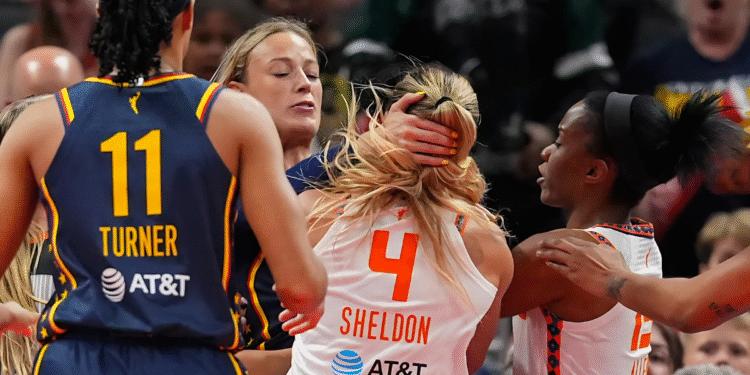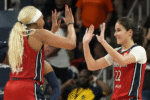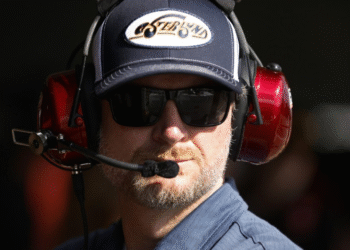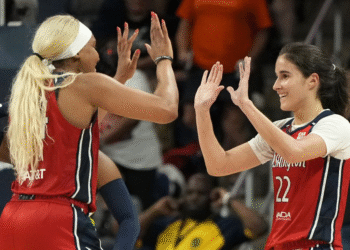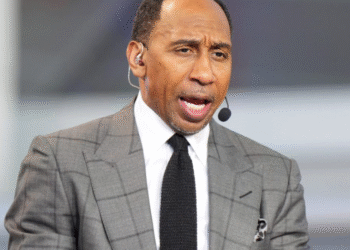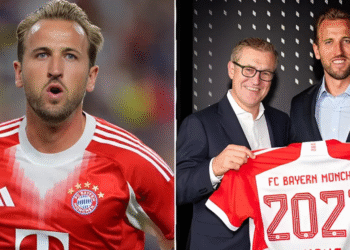Caitlin Clark’s entry into the WNBA has been nothing short of explosive—not just in terms of fan excitement, but also in the aggressive and, at times, dangerous play she’s been facing. On what should’ve been a regular game night, it turned into yet another moment of controversy and conversation around how the league is treating its brightest new star.
The Indiana Fever rookie and NCAA all-time scoring leader has been the face of the WNBA’s most recent surge in popularity. With packed arenas, higher viewership, and even more merchandise sales, Clark’s presence is undoubtedly bringing in attention. But that attention also seems to have come with a target on her back. During a recent game, what many called a “hard foul” turned into a clear sign that the on-court aggression toward Clark is getting worse.
It wasn’t the first time either. Since the season began, Clark has been on the receiving end of multiple incidents—elbows, shoves, flagrant fouls—all brushed off as “part of the game” by some, but clearly raising eyebrows among fans and analysts. The most recent one involved Chicago Sky’s Chennedy Carter, who delivered a hard body check well after play stopped. While the league eventually upgraded it to a flagrant foul, it raised bigger questions: why does it take so long for the WNBA to act? And why are these moments becoming more common?
Many believe it’s a mix of jealousy, resistance to change, and plain old competitiveness. Clark isn’t just a rookie—she’s a disruptor. She came in with record-breaking college fame, a huge fanbase, and corporate endorsements. She’s drawing millions of eyeballs to the league. But some players seem to feel she hasn’t “earned her spot” yet. So, instead of embracing the momentum she brings, the league appears caught between supporting its current players and adapting to a new era.
What’s worrying is the lack of consistent officiating and player protection. In a league that often claims it wants to grow and attract younger fans, letting these incidents slide or addressing them only after social media outcry doesn’t look good. Fans tuning in to watch their favorite new player are also watching her get shoved to the floor, with little immediate consequence. That’s not just unfair—it’s bad for the league’s image.
Clark has handled these situations with calm and maturity, rarely reacting or retaliating. But it’s not her job to play through unsafe conditions. It’s the responsibility of the WNBA to protect its players—especially its rising stars. Every league protects its most marketable talent. The NBA does it. The NFL does it. If the WNBA wants to grow its audience and keep it, it needs to do the same.
Off the court, the reactions have been mixed. Some veteran players say Clark is getting “welcome to the league” moments. Others have defended her, saying no one deserves targeted hits and that the aggression has crossed a line. Fans, meanwhile, are growing louder, calling out the imbalance and demanding the league do more. Even sports commentators who usually steer clear of WNBA topics are now weighing in, which shows just how wide the conversation has spread.
It’s important to note that this isn’t just about Clark—it’s about what kind of league the WNBA wants to be. If it continues to allow these types of incidents without timely response, it risks pushing away new fans and sponsors. The product—the game—has to be entertaining but also fair. Right now, the message seems mixed: we want growth, but we won’t change how we operate.
The WNBA is at a turning point. Caitlin Clark may be the flashpoint, but the bigger issue is about respect, safety, and how much the league values its players—especially the ones driving its future. Every elbow, every hit, every slow response from the referees or the league office chips away at trust.
Clark’s rise is good for everyone in the WNBA. She’s not taking anything away—she’s bringing more to the table. If she succeeds, the league succeeds. But only if she’s allowed to shine without being dragged down by unnecessary roughness and outdated locker-room mentalities. The WNBA has an opportunity here—to embrace a future that looks brighter than ever. But only if it protects the stars that are lighting the way.
